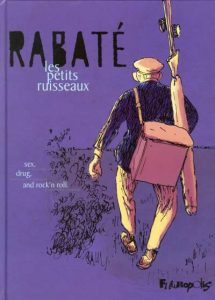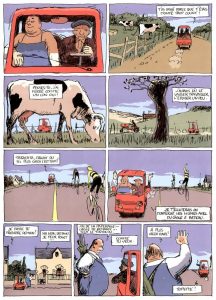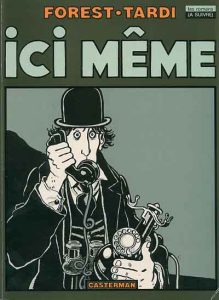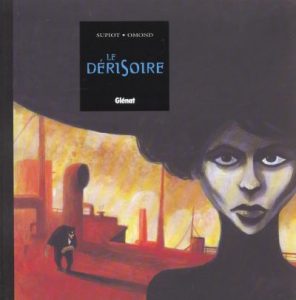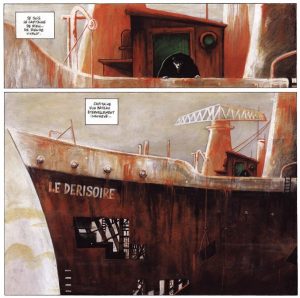Looking for a new trashy teen drama after Elite went off the rails? Don’t worry, I got you covered.
Continue reading “Rebelde: Battle of the Bands—but make it a telenovela.”“Große Freiheit” Review: A Defence of Liberation for its own Sake
Sebastian Meise’s 2021 feature film, Große Freiheit (Great Freedom) is an exhilarating, though heartbreaking account of one man’s relentless refusal to adhere to the norms of a system without mercy, no matter the cost.
Continue reading ““Große Freiheit” Review: A Defence of Liberation for its own Sake”Recommendation: Luis Miguel

Today’s blog post brings a music and television recommendation all in one.
Luis Miguel: La Serie is a Netflix drama series that follows the life of legendary Mexican singer Luis Miguel throughout his early life and rise to superstardom. This show intimately explores Luis Miguel’s private life, focusing on the challenges he went through to balance his public image with his relationships with friends and family. With beautiful camerawork, fun 80s aesthetics, and a heavy dose of LuisMi’s most popular songs, this series keeps you hooked from beginning to end. It’s no surprise that it has become a favorite in the Spanish-speaking world.
Luis Miguel is currently available on Netflix. Keep an eye out for the third season, coming out today (October 28th)!
Or, if you’re just looking for something to listen to, here are some of my favorite Luis Miguel songs:
French graphic novels in the Reed College Library
Graphic novels are a huge form of popular media in France. Most French public libraries dedicate a large section to the bande dessinée alongside more typical forms of literature. French graphic novels have a flavor that is somehow both romantic and sordid, and a pace that runs much slower than a comparable American comic strip (the French are less concerned whether the story has a hero, follows an arc, or moves towards any resolution). They are typically very funny. Lucky for us, the Reed College library has several shelves of French bandes dessinées! For this blog, I read and reviewed four of them.
Most of the stories I read for this blog are in the realm of the fantastic, and I recommend going through slowly to absorb both images and the text. Sit down with a notebook and a dictionary, and plenty of time to take in both art and storytelling. These books are accessible to intermediate or advanced readers.
Finally, these graphic novels are a great source of new vocabulary since they include plenty of colloquialisms. A set of flashcards on Quizlet is linked below with my favorite words and phrases from the bandes dessinées I read.
https://quizlet.com/237885378/french-phrases-of-interest-flash-cards/
Les petits ruisseaux, Pascal Rabaté. 2006.
Call no. PN6747.R33 P48 2006
This story follows an old man named Emile who no longer finds much meaning in his old age. One day while out fishing, his best friend tells Emile to stop pitying himself and take full advantage of life while he can. Emile’s quiet life of solitude ends abruptly when he starts to take this advice. Do we assume that life and lust belong to the young? The tricks up his sleeve are predictable, but Emile’s character is compelling and it’s funny to see his sleazy side let loose. This bande dessinée won the Grand Prix de la Critique in 2007 from L’Association des Critiques et journalistes de Bande Dessinée (ACBD). It was made into a film in 2010.
Ici Même, Jean-Claude Forest et Jacques Tardi. 1979.
Call no. PN6747.F687 I35 2006
This is a strange fairy tale about a man who lives atop the walls surrounding a neighborhood. He is not allowed to descend or set foot on the land below. Arthur Même, as the man is called, walks a fine line between dignity and mania, satire and hyperbole, as he gatekeeps for the wealthy socialites beneath the walls. A boatman comes once a day to deliver mail, cheese and wine. These are Arthur’s only interactions. The plot is full of tropes (spies, an ancient inheritance, war between the families, and a love affair) but intriguing nonetheless for its oddity. The novel is in black and white.
Le Dérisoire, Olivier Supiot et Eric Omond. 2002.
Call no. PN6747.S85 D4 2002
Le Dérisoire is a mix between Moby Dick and Alice in Wonderland. It features a solitary captain on a derelict ship in the ocean, going nowhere, in despair about his situation and his inability to fix it. His crew are all skeletons, having died some time ago, yet somehow remaining on board the ship. It seems that nothing ever leaves the ship and the ship itself never leaves. The furnace at the heart of the ship has gone out, leaving only cold empty steel, but still it floats. And which of the characters are living? Into this drifting tapestry comes a phantom woman, Constance, who brings color and life onto the ship. Is she real? Is the ship? Is anyone? The graphic novel has a dreamy watercolor-like style and is beautiful enough that it doesn’t matter that the plot doesn’t make sense.
5 est le numéro parfait: 1994-2002, Igort, translated from Italian by Lidia Licari. 2002.
Call no. PN6767.I36 A6314 2002
This graphic novel was originally a three-part series that was later collected into one large volume. It follows a family in Naples embroiled in classic 50s-era mob drama. Think The Godfather–there’s shootouts in the woods, religious symbology, intimate family scenes, rivalries and backstabbing. The book moves quickly, lots of people get shot, and there is only one woman, the damsel in distress. This is a true Italian action comic, with a minimalist art style in grayscale and simple block colors. The author, who writes under the name Igort, has been at the center of the Italian comic scene for decades and published many other graphic novels. 5 est le numéro parfait is his most famous.
Copyright: All images taken from www.bedetheque.com/
“Les petits ruisseaux,” Pascal Rabaté. Futuropolis. 2006. https://www.bdgest.com/chronique-1530-BD-Petits-ruisseaux-Les-petits-ruisseaux.html?_ga=2.50200686.916534693.1512955637-12593617.1508988380
“Ici Même,” Jean-Claude Forest et Jacques Tardi. Casterman. 1979. https://www.bedetheque.com/serie-1684-BD-Ici-Meme.html
“Le Dérisoire” Olivier Supiot. Glénat. 2002. https://www.bedetheque.com/serie-6173-BD-Derisoire.html
“5 est le numéro parfait,” Igort. Casterman. 2002. https://www.bedetheque.com/serie-5200-BD-5-est-le-numero-parfait.html
恨海 ‘The Sea of Regret’
This novel was written by Wú Jiǎnrén in 1906. In ten chapters, the reader follows the story of two couples and their families as they head to Shanghai to escape the turmoil during the Boxer Rebellion in 1900. This would be recommended for intermediate to advanced learners, but the translated version also provides insight into the discussion around family, marriage, and the status of women at the time.
12 Contemporary German Films
Watching full-length films in German is one of the best ways to practice your language skills while also having fun. German cinema, dating back to classics like “The Cabinet of Dr. Caligari” (1929), is full of incredibly beautiful films. What’s sometimes harder to find are films released within our lifetimes, so here are 12 Contemporary German Films (in alphabetic order) from several genres, all of which are available at the Reed Instructional Media Center.
“Barbara” (2012): Barbara, an East German doctor, is sent to work in a small town hospital as punishment for requesting to leave the country. While planning an escape to the West, she discovers she has reasons to stay. A personal and touching drama, Barbara is also a vignette of life in East Germany.
“Bella Martha” / “Mostly Martha” (2001): A touching German romantic comedy about Martha, a woman trying to balance her passion as a chef with the difficulties of caring for her stubborn niece. Martha herself is as fiery and stubborn as her niece, and they often butt heads, but the introduction of a friendly, good-looking Italian chef seems to have an effect on their relationship.
“Das Experiment” / “The Experiment” (2001): Loosely based on the Stanford prison experiment, Das Experiment imagines the psychological toll on a group of people randomly assigned roles as “prisoners” or “guards”. Moritz Bleibtreu, one of Germany’s most famous actors, stars in this dark thriller.
“Das Leben der Anderen” / “The Lives of Others” (2006): Possibly the most acclaimed modern film to come out of Germany, Das Leben der Anderen is about East German surveillance during the Cold War. A Stasi officer, listening in on a young couple, becomes fascinated with their lives. The film has won numerous awards for its dramatic brilliance and accurate display of the historical atmosphere, and is a must-see.
“Der Untergang” / “Downfall” (2004): An epic drama about the final days of the Nazi regime, Der Untergang is told from the perspective of Traudl Junge, Hitler’s personal secretary. The film dramatises the events that lead up to Hitler’s downfall, while dealing with themes of responsibility and guilt.
“Fack ju Göhte” (2013): The German equivalent of a Jack Black film, Fack ju Göhte is about a former bank robber who mistakenly gets hired as a substitute teacher. Although you’ll probably never see this film on a syllabus, it’s universally well-known in Germany as one of the funniest and stupidest films of our generation.
“Good Bye, Lenin” (2001): Set during the Reunification of West and East Germany, Alex has to protect his mother, who awoke from a coma to a brand new world. He reconstructs a mini-GDR in her apartment, but the deception goes too far and he starts to blur reality and fiction. An excellent watch for those interested in post-unification German culture, history, and comedy!
“Herr Lehmann” / “Berlin Blues” (2003): Just before the German reunification, Herr Lehmann introduces us to Frank Lehmann, a twenty-something bartender living lazily in West Berlin. When his parents come to visit, his depressingly boring life is upset, and he has to reevaluate his lifestyle. If you’re looking for an enjoyable and fun film, this isn’t it, but it’s a great period piece full of clever dialogue.
“Lola Rennt” / “Run Lola Run” (1998): Lola is thrust into a dangerous situation by her boyfriend, Manni, and has twenty minutes to collect 100,000 deutsche Marks, and so she runs…and runs…and runs. The rest can only be described as an MTV-inspired thriller with as many experimental techniques as you can hope to cram in an 80-minute film. A cult classic action-thriller with a plot and characters so energetic, you’ll be breathless yourself by the end.
“Sophie Scholl: Die letzten Tagen” (2005): Based on a true story, this epic drama recreates the final days of Sophie and her brother, two members of an underground resistance group in Nazi Germany called the “Weiße Rose”. Although the film is tragic and may leave you weeping, it’s narratively excellent and cinematographically beautiful.
“Türkisch für Anfänger” (2012): One of the more ridiculous suggestions on this list, this film is essentially a goofy spin-off of “Lost”. Four teenagers get stranded on a beautiful desert island and have to put aside their caricaturised differences and get along. Full of politically-incorrect stereotypes and language, Türkisch für Anfänger will set you up perfectly for a trip to Germany.
“Vincent will Meer” / “Vincent Wants to Sea” (2010): A young man with Tourette’s wants nothing more than to escape his mental institution and take a trip to Italy. With the help of Marie, a woman with an eating disorder, the two break out and take a road trip full of misadventures.
